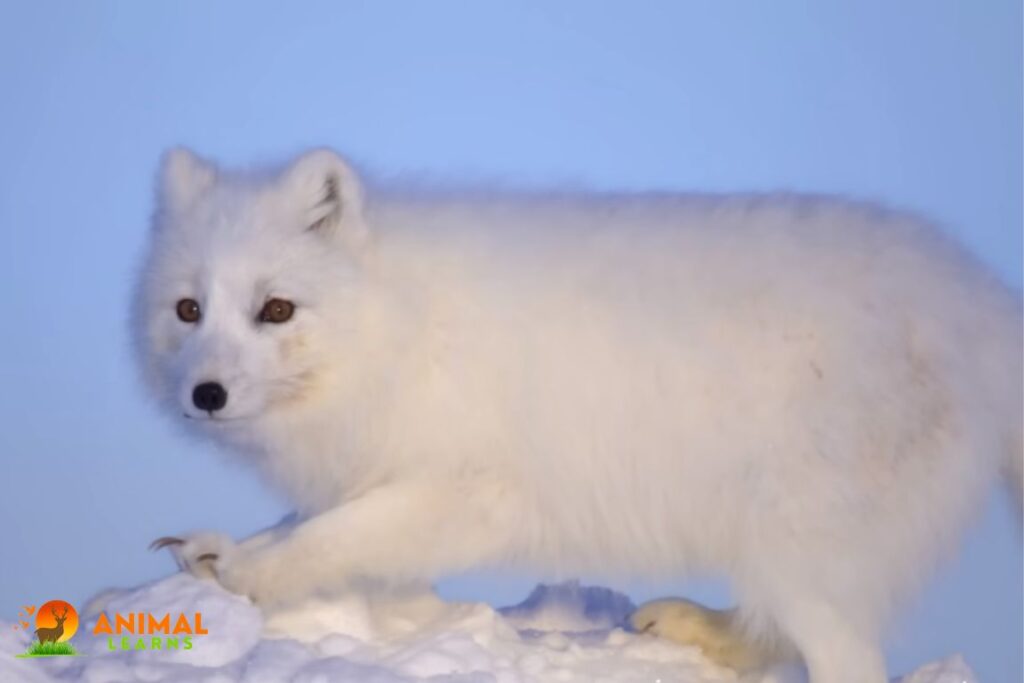Arctic Fox: Surviving the Frozen Tundra – Animallearns

The Arctic fox is a master of survival in the frozen wilderness. This amazing animal, also known as the white fox or polar fox, belongs to the dog family. It has a short and round body, with a length of about 50–60 cm and a weight of 3–8 kg.
The Arctic Fox, found in cold northern regions, exhibits a remarkable contrast to both the Canadian Marble Fox and the Bengal Fox, as its adaptations to extreme climates set it apart from these other fox species.
It can withstand temperatures as low as -70°C (-94°F), thanks to its thick fur that covers its entire body, including its small ears, muzzle, and feet.
The Arctic has many other adaptations that help it cope with the harsh climate. It digs burrows under the ground or snow to shelter from the wind and predators.
It can change the color of its fur from white to brown or gray depending on the season, blending in with its surroundings. It can also use its long and fluffy tail as a scarf or a blanket to keep warm.
This is a remarkable example of how nature can create creatures that are perfectly suited to their environment. It is not easy to spot this elusive fox in the snow-covered landscape, but if you do, you will witness one of the most amazing animals on Earth.
Adaptations
Contents
The Arctic tundra is a land of ice and snow, where only the most adaptable animals can survive. One of these animals is the fox, a small and furry creature that has evolved amazing adaptations to cope with the harsh climate.
The fox has a thick fur coat that keeps it warm and changes color with the seasons. In winter, it becomes white to hide in the snow, while in summer, it turns brown or gray to match the rocks and dirt.
This is also a clever hunter and scavenger, able to find and dig up food under the snow, such as rodents and eggs.
The Arctic has a compact body shape that helps it conserve heat and short legs and muzzle that reduce heat loss. These remarkable adaptations allow the fox to live and thrive in its icy home.
Distribution
This fox is a furry animal that lives in many places around the North Pole. This animal, also called the polar fox, can be found in a large area that surrounds the Arctic Circle. It lives in the cold regions of North America, Europe, and Asia.
Some of the countries where you can see the Arctic fox are Canada, Alaska, Greenland, Iceland, Scandinavia, Russia, and some islands in the Arctic.
Arctic Fox Habitat
This is a remarkable animal that can survive in some of the harshest places on Earth. Also known as Vulpes lagopus, this species lives in the frozen lands of the Arctic and subarctic regions of the Northern Hemisphere.
It has a thick coat of fur and a sturdy body that helps it stay warm in the bitter cold. It also makes cozy dens in the snow or soil to protect itself and its young from the elements.
The Arctic depends on small animals like lemmings and ptarmigans for food and follows them wherever they go. In this stunning and unforgiving habitat, the Arctic has shown amazing adaptability and resilience.
Diet
This fox is a clever hunter that can find food in the most extreme conditions. This animal eats mostly small mammals like lemmings, voles, and Arctic hares, which are plentiful in the tundra.
These furry creatures are the main food source for the fox in the summer. But when winter comes and food is hard to find, the fox changes its diet.
It scavenges dead animals, hunts birds like ptarmigans, and even eats berries and plants. This shows how the fox can adapt to different situations and survive in the harsh Arctic landscape.
Migrations and travel

This is an amazing traveler that can roam far and wide in the frozen Arctic. This animal often moves long distances to find food, especially in the winter when food is rare.
The fox follows a special movement pattern every season, where it may wander across the tundra, ice, and coast, sometimes going hundreds of miles. It tracks the changes in its main food source, such as lemmings and Arctic hares.
This wandering lifestyle shows how the Arctic can cope with extreme cold, uncertain food supply, and changing Arctic conditions. This fox is a true survivor and adapter in one of the toughest places on Earth.
Physical characteristics

This fox is a master of survival in the freezing Arctic. It has thick, fluffy fur that keeps it warm in the cold.
It also changes its fur color with the seasons, from white in the winter to blend in with the snow, to brown or gray in the summer to hide on the ground and rocks.
It has a small and strong body, with short legs and a furry tail that helps it stay warm.
It has small ears and a round face that helps it lose less heat and sharp senses of smell and hearing that help it find prey under the snow.
These features make the Arctic fox well-adapted to its harsh environment and a true icon of the Arctic wildlife.
Facts about Arctic Fox

The Arctic is a wonder of nature that lives in the freezing Arctic. It has many amazing facts that show how it adapts and survives in this harsh environment:
- Changing Colors: The Arctic changes its fur color with the seasons. It has a white coat in winter to hide in the snow and a brown or gray coat in summer to blend in with the ground.
- Cold Survivors: These foxes can handle very cold temperatures, as low as -70°C (-94°F). They have thick fur, fat layers, and snow tunnels to keep them warm.
- Flexible Eaters: These foxes eat many kinds of foods. They hunt small animals like lemmings, birds, and fish. They also eat berries, plants, and dead animals. They can find food in different situations.
- Long Travelers: Foxes move a lot to find food. They may go hundreds of miles when food is scarce. They follow their prey wherever they go.
- Family Life: These foxes have interesting family lives. They usually stay with one partner during the breeding season. Both parents help raise the pups, which can be up to 14 in a litter.
- Short Lives: In the wild, the Arctic live for about 3-4 years because of the tough conditions and predators. In captivity, they can live longer, up to 14 years.
- Ice Crossers: Some foxes travel very far, even across the Arctic Ocean. They use the ice as a way to get to new places or find new homes.
- At Risk: Fox populations are mostly stable, but they face threats from environmental changes. Climate change affects their main prey and their survival.
- Night Hunters: These foxes are mostly active at night when prey is easier to catch and it is slightly warmer.
- Not So Social: While they are not very social animals, these foxes may form small groups or meet other foxes when they share food.
Arctic fox facts show how amazing these animals are and how they cope with one of the most difficult environments on Earth.
Conclusion
The Arctic fox is an amazing animal that lives in the freezing Arctic. It has many features that help it survive in this harsh environment. It has thick fur that changes color with the seasons, from white to brown or gray. It moves a lot to find food, following its prey wherever they go.
It can handle very cold temperatures, as low as -70°C (-94°F). These small hunters have interesting behaviors, such as their family life and their varied diet.
They face threats from climate change and habitat changes, but they are still able to live in one of the toughest places on Earth. They also show us the environmental problems in the Arctic, which is changing fast. The Arctic fox is a wonder of nature and a reminder of the importance of protecting our planet’s ecosystems.
FAQs
What is an Arctic fox?
This is a clever and adaptable fox that lives in the frozen lands of the Arctic and subarctic regions.
How does this fox survive in its extreme habitat?
The Arctic has thick, fluffy fur that protects it from the cold. It also stores fat in its body to keep warm and energy. It can dig cozy dens in the snow to shelter itself from the wind and snow.
What is the primary diet of these foxes?
The Arctic hunts small animals like lemmings, birds, and fish for food. It also scavenges dead animals when it can.
How does the Arctic fur change with the seasons?
The fox changes its fur color with the seasons to hide from predators and prey. It has a white coat in winter to blend in with the snow and a brown or gray coat in summer to match the ground.
Do white foxes migrate?
This fox is a wanderer that roams far and wide in the Arctic. It often moves long distances to find food, especially when the winter is harsh.
What role do white foxes play in their ecosystem?
The white fox is a vital hunter that helps keep the balance of Arctic ecosystems. It hunts small animals and prevents them from overpopulating and harming the environment.
Are fox populations threatened by climate change?
The Arctic faces threats from climate change, which affects its food supply. It relies on small animals like lemmings for food, but climate change can make them less available. This makes it harder for the fox to survive.
What is the lifespan of an Arctic in the wild?
The fox has a short life in the wild, lasting only about 3-4 years. This is because of the tough conditions and predators it faces in the Arctic.












